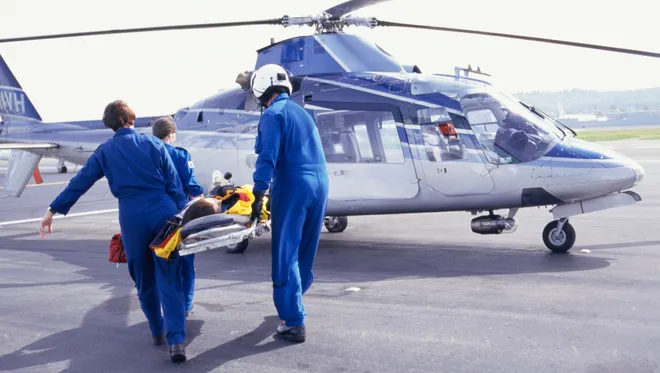The act of traveling creates an exciting moment regardless of whether someone uses it for rest work or family gatherings. Medical emergencies that cannot be predicted might destroy the enchantment of what was meant to be a vacation. Immediate specialized medical attention often becomes necessary whenever a person experiences serious accidents or illnesses in locations where local healthcare facilities do not provide these services.
It remains critical to select travel medical insurance with air evacuation home coverage to qualified medical facilities for this reason. This article demonstrates why complete travel insurance matters to US visitors while exposing limited coverage risks and presenting air evacuation advantages.
Why Travel Medical Insurance is Essential
Quality healthcare becomes uncertain for travelers who leave their domestic territory. Healthcare costs remain tremendously expensive throughout the United States along with other nations. Your travel medical insurance provides financial defense against unforeseen health problems to ensure you get essential medical help free of heavy expense.
Key Benefits of Travel Medical Insurance
- Emergency Medical Treatment
Travel insurance provides comprehensive coverage for hospital stays as well as surgical operations and medical treatments that happen when tourists become sick or injured on their travels. Your insurance coverage guarantees swift access to top-quality medical treatment during both small medical problems and serious health emergencies at all times.
- Air Evacuation to a Qualified Facility
Maximizing your access to professional healthcare requires travel medical insurance which enables emergency air transport to qualified medical facilities that hold proper treatment facilities when faced with serious medical conditions in remote or understaffed areas. This significant benefit ensures air evacuation costs are covered because these expenses reach tens of thousands of dollars when there is no insurance.
-
Medical Repatriation
Medical repatriation benefits the cost of transporting someone with severe illness or severe injury back to their home country for further treatment during a life-threatening situation. Specialized transport services would be included along with access to care under familiar conditions from providers you trust.
-
Peace of Mind
When traveling you should experience personal enrichment instead of anxiety. The purchase of complete travel medical insurance lets you explore freely because unexpected healthcare costs together with emergency evacuations and repatriation expenses will not become financial challenges. Travelers of every age group benefit from this coverage particularly when visiting the USA because medical expenses there are quite expensive.
Get a membership now!
Protect Your Health Anywhere in the World with Expat Global Medical! Get Comprehensive Coverage, Including Air Evacuation with MEDJET ASSIST.
Understanding Air Evacuation Home Coverage
Travel medical insurance includes essential coverage for air evacuation transportation from the destination back to home. The process of air evacuation enables patients to receive the best possible care at medical facilities when they need urgent life-saving treatment. Without travel insurance, a traveler must pay massive costs for emergency transfers because these fees often cost $100,000 depending on their location and medical severity.
What is Air Evacuation?
Air evacuation or medical evacuation (medevac) serves as the method to move seriously ill or injured travelers to medical facilities that offer lifesaving medical care. The service proves crucial for individuals who visit remote locations and developing nations and regions that consist mainly of limited healthcare infrastructure.
Air ambulances which include fixed-wing aircraft and helicopters perform evacuation services through their equipped life-support systems and medical crews on board. Life-threatening medical cases may lead to the decision to transfer patients back to their home country for specialized medical care when necessary.
When is Air Evacuation Necessary?
Immediate advanced medical care defines conditions that require patients to be transported by air to survive. Some common scenarios include:
-
Severe Trauma Cases
Speedy medical help becomes necessary in instances of severe traumatic accidents which include car wrecks as well as serious falls and high-intensity sporting accidents. Head trauma together with spinal injuries and internal bleeding require transporting patients to a trauma center that includes both neurosurgery and critical care facilities because this difference determines their survival.
-
Acute Medical Conditions
Life-threatening acute medical situations including heart attacks strokes and respiratory failure along with aneurysms require patients to access specialist neurological and cardiac medical care. The absence of appropriate hospital services at local healthcare facilities produces substantial risks regarding both fatalities and prolonged medical consequences.
-
Medical Emergencies in Remote Areas
Access to proper medical care becomes limited for travelers who choose distant or rurally located or undeveloped healthcare system areas. The need for medical evacuation arises whenever a local healthcare facility operates without critical care units, ventilator equipment, or trauma specialist personnel.
-
Infectious Disease Outbreaks & Public Health Crises
Travelers should receive urgent transportation to facilities with advanced isolation capabilities when they have severe infections that progress to sepsis or pandemic conditions.
-
Specialized Treatment Requirements
Specific diseases including serious burns organ failure and uncommon medical conditions demand medical equipment and specialist knowledge which particular countries do not have. Patients benefit from specialist medical attention through air evacuation because it allows them access to maximal recovery results.
Why Air Evacuation is Critical for Those Visiting the USA
Travel insurance becomes vital for international visitors going to the USA because the healthcare system demands exorbitant medical costs. A private healthcare approach functions in the U.S. while most subsidized healthcare nations follow different systems.
This generates hospital fees reaching thousands of dollars in the U.S. Air evacuation insurance during a critical illness or serious accident determines whether the patient gets quick emergency medical care while avoiding costly healthcare debts.
Cost of Medical Care in the USA
Medical services in America are renowned for their superior quality yet Americans pay the most expensive healthcare fees in the entire world. Consider these staggering expenses:
- Hospital patients face expenses over $2,500 per day for regular care which exceeds much higher amounts for cases needing intensive care.
- The cost of emergency surgery including heart attacks and severe injuries surpasses $50,000.
- Both medical equipment requirements and transport level standards impact the probable costs of air ambulance trips which fall between $25,000 and $200,000.
Why Travel Medical Insurance with Air Evacuation is a Must
Travelers must bear all medical costs without coverage because insurance failure leads to both massive healthcare finances and treatment refusals from lack of funds. A complete insurance policy that includes air evacuation services will take you to the highest quality medical center without creating massive financial challenges.
How to Choose the Right Travel Medical Insurance Plan
Travelers must bear all medical costs without coverage because insurance failure leads to both massive healthcare finances and treatment refusals from lack of funds. A complete insurance policy that includes air evacuation services will take you to the highest quality medical center without creating massive financial challenges.
1. Confirm Air Evacuation Coverage
A standard travel medical policy does not include air evacuation as part of the standard package. Medical policies offer different levels of coverage such that while some can arrange local ambulance services or basic medical transfers only. The emergency air evacuation section must include clear provisions for fast transportation to qualified medical centers near your location as well as your home country in case of medical necessity.
2. Check Coverage Limits
Emergency air evacuation services will budget between $25,000 and $200,000 based on how far the patient needs to be transported as well as the necessary medical care. Select a policy that includes between $100,000 and $500,000 of emergency medical evacuation benefits. Insufficient coverage quantity leads to denied transportation services or excessive payments outside usual expenses.
3. Verify Coverage for Pre-Existing Conditions
Medical coverage plans frequently deny service to patients who have existing health problems starting from before their policy initiation date. Travelers who have chronic conditions should select medical insurance plans providing pre-existing condition waivers because the benefits will protect them from denial of air emergency services during travel.
4. Assess the Network of Medical Facilities
Search for medical facilities that belong to the network the insurance provider approves. Medical facilities of renowned status along with specialized trauma centers increase the chances of patient recovery and survival rates. The policy either grants freedom to choose any medical facility or requires hospital stays within their network.
5. Look for Repatriation Benefits
The ability to go back home with medical transport becomes possible after stability with this coverage plan. The coverage benefit includes medically equipped flight expenses that ensure policyholders receive professional medical assistance throughout their operations. Additional security both financially and medically emerges from coverage policies which include repatriation provisions.
6. Review Policy Exclusions and Fine Print
Travel medical insurance plans establish coverage boundaries through various conditions including the length of your trip and your age along with high-risk behavior participation or the status of the war zone. Examine all fine print to understand which instances would prevent you from accessing your air evacuation coverage as needed.
How to Use Your Air Evacuation Benefits in an Emergency
Mastering your travel medical insurance usage requires a basic understanding of how to activate it during emergencies. In case of medical evacuation follow these steps to proceed.
- Immediately contact your insurance provider because most companies operate emergency hotlines that function 24 hours daily. Tell them about medical emergencies whenever they occur.
- The insurance provider needs to conduct medical assessments before making approval decisions about air evacuation needs. The insurance provider assigns responsible personnel who organize the transportation to an optimal facility.
- The insurance provider will organize air transport including air ambulance or medical flights when evacuation gets authorized.
- Incoming patients will be medically treated in facilities that can manage their condition.
- The insurer will arrange the transportation of your return home if needed when you reach medical stability.
Conclusion
The essential element for planning international travel involves selecting travel medical insurance that provides air evacuation home coverage. The right coverage enables medical evacuation to a qualified facility providing the best medical care while protecting you from severe financial loss during a foreign emergency.
Every international visitor to the USA must obtain excellent travel insurance with medical evacuation provisions because American healthcare expenses are too expensive. Review insurance policies before traveling so you can choose coverage that includes air-based transportation to medical facilities since this lifesaving protection might matter in uncertain moments.


